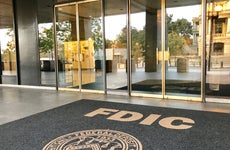What to do if you can’t open a bank account

The Bankrate promise
At Bankrate we strive to help you make smarter financial decisions. While we adhere to strict , this post may contain references to products from our partners. Here's an explanation for .
Our writers and editors used an in-house natural language generation platform to assist with portions of this article, allowing them to focus on adding information that is uniquely helpful. The article was reviewed, fact-checked and edited by our editorial staff prior to publication.
Key takeaways
- Common reasons consumers are turned down for a bank account include a history of overdrafts, unpaid bank fees or suspected fraud.
- Applications can also be denied due to mistakes on one's checking account report.
- If you've been denied a bank account, ask the bank why this happened.
- Depending on why you were turned down, you may be able to move forward by clearing up your checking account report, trying a different bank or using alternative banking products.
Setting up a bank account can be the first step in getting your financial future on track. But just like with a credit card application, not everyone gets approved for a bank account.
If you’re struggling to open a bank account, you’re not alone. Many consumers are unable to open accounts because of problems with a past bank account, such as unpaid fees or a history of overdrawing the account. No matter what circumstances brought you to this point, there are still options, though they may take some persistence.
What do you need to open a bank account?
You’ll need to fill out an application whether you’re applying for a bank account online or in person at a bank branch. The information you’ll need often includes:
- Identification, such as a driver’s license or passport
- Social Security number
- Date of birth
- Phone number
- Money to fund the account, whether it’s cash, a check, or bank account information to make a transfer
Find out why you were rejected
Finding out your bank account application was rejected can be upsetting. Instead of dwelling on the bank’s decision, however, find out why the bank rejected your application, so you can move forward.
Common reasons why consumers are turned down for bank accounts include:
- Past bank accounts that were closed due to negative balances
- History of overdrafts, unpaid bank fees or suspected fraud
- Errors in your checking account report, such as showing someone else’s information
- Your application is incomplete or contains errors
“Consumers who find themselves unable to open a bank account are probably in this position because they have misused their bank accounts or they have bad credit,” says Howard Dvorkin, CPA, and author of “Power Up: Taking Charge of Your Financial Destiny.”
Contact a bank representative and ask why your application was rejected. If you know what the issue is with your application, you’ll be able to take action to resolve it before your next attempt. It might be as simple as providing further identification, or there may be a more serious issue in your financial history or an error.
Try a different bank
After finding out why a bank rejected your application, try working with a different bank. Banks and credit unions across the country have different rules when it comes to application approval. Some banks, for example, may deny an application made by someone who recently filed bankruptcy. Others require you to pay any outstanding bank account fees before allowing you to open a new account.
Bankrate can help you shop around for the best checking account to suit your needs.
Clear up your checking account report
If you have a blemished bank account history, banks can learn about it from reporting agencies such as ChexSystems or Early Warning Services. These companies provide banks with details of problems consumers have had with bank accounts in the past.
Typically, things on your report that banks consider to be red flags include serial overdrafts, bounced checks or unpaid fees. If you have a negative record, banks might refuse to work with you as a new customer.
If you want to clear up the report, start by getting a copy of it. You can obtain free reports from ChexSystems and Early Warning Services every year to monitor your record.
There are steps you can take to improve your checking account report, such as paying off any unpaid bank fees. Once the bank advises the agency that you’ve paid these fees, the report can be updated accordingly.
It’s also important to review the report for any errors that may keep you from being approved for a bank account. Both ChexSystems and Early Warning Services allow you to submit disputes on their websites so that mistakes can be corrected. After any errors have been removed, you can then resubmit your application to the bank.
Alternatively, if you are unable to clear up your report, consider other options. Not all banks use reports from ChexSystems or Early Warning Services to make a decision on whether you can get a bank account, and going with a bank that doesn’t use those services may be your best bet.
Take a financial education course
Organizations such as Bank On work to provide communities with financial literacy education, in addition to helping connect unbanked and underbanked consumers with checking accounts.
“If you’ve had troubles with your bank accounts in the past and feel like you’ve been blacklisted, look for a Bank On program near you,” says Todd Christensen, an education manager at Money Fit by DRS Inc., a nationwide nonprofit financial wellness and credit counseling agency. “Usually, after taking a few hours of basic money management courses, you can automatically qualify for an account with participating banks or credit unions.”
Not only can taking a course help you get a checking account, but it also helps you learn some helpful money management skills.
Use alternative products
It might take some time before you can obtain a standard bank account. In the meantime, you can make use of alternative banking products.
Second-chance checking accounts
A second-chance bank account functions much like a traditional checking account but with some account restrictions.
With a second-chance account, you may need to pay a higher monthly fee or maintain a bigger balance, to protect the bank in the event of problems such as overdrafts.
When opening a second-chance bank account, you may wish to find out about the transition process to a regular checking account. Most banks have clear guidelines that can help you switch over to a regular checking account at some point.
Prepaid cards
If you are struggling to open a bank account, a prepaid card can be a good alternative if you don’t want to pay with cash but lack access to a checking account. Prepaid cards must be front-loaded (monetary value added to them) before they can be used for purchases.
In 2021, 6.9 percent of U.S. households used reloadable prepaid cards, according to a survey from the Federal Deposit Insurance Corp. (FDIC). An advantage of prepaid cards is they can’t be overdrawn, so you won’t incur overdraft fees. A downside, however, is prepaid cards won’t help boost your credit score, since they don’t grant you a line of credit.
Bottom line
A bank account can be a doorway to financial success. Although it may take time to clean up your banking history, it can be done once you’ve made a commitment to changing your financial habits for the better.
–Freelance writer Sarah Sharkey contributed to a previous version of this article.
Related Articles



